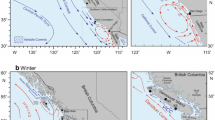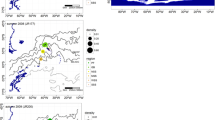Abstract
Geographic ranges of marine intertidal organisms are not entirely governed by discontinuities in temperature gradients. This is especially true in the eastern north Pacific Ocean, where temperature gradation is less steep than in the western north Atlantic Ocean. The southern limit of distribution of Littorina sitkana (Philippi, 1845) and the northern limit of L. planaxis (Philippi, 1847) occur at Charleston, Oregon (Latitude 43.4°N). No discontinuity in air or water temperature can be correlated with these distributional boundaries. A third species, L. scutulata (Gould, 1849), has the widest range, overlapping with L. planaxis in the south and L. sitkana in the north (Latitude 27.5° to 58°N). L. planaxis transplanted to northern Washington survived for 4 years, grew and produced planktonic larvae. Either larval mortality or south-flowing currents during planktonic life prevent this species from dispersing northward. L. sitkana has direct development and occurs only in habitats where adults are sheltered from waves and egg masses from desiccation. Lack of suitable habitat, coupled with the presence of the predatory crab Pachygrapsus crassipes (Randall, 1839) prevent the southward establishment of L. sitkana.
Similar content being viewed by others
Literature Cited
Barnes, C.A., A.C. Duxbury and B.A. Morse: Circulation and selected properties of the Columbia River effluent at sea. In: The Columbia River estuary and adjacent ocean waters, 868 pp. Ed. by A.T. Pruter & D.L. Alverson. Seattle & London: University of Washington Press 1972
Behrens, S.: The role of wave impact and desiccation on the distribution of Littorina sitkana Philippi, 1845. Veliger 15 129–132 (1972)
Behrens, S.: Ecological interactions of three Littorina (Gastropoda, Prosobranchia) along the West Coast of North America. Ph.D. thesis, University of Oregon, Eugene 1974
Behrens Yamada, S.: Range extension in Littorina sitkana and range contraction in Littorina planaxis (Mollusca, Gastropoda). Veliger 19 (3), (1977). (In press)
Dall, W.H.: Summary of the marine shellbearing mollusks of the northwest coast of America, from San Diego, California, to the Polar Sea, mostly contained in the collection of the United States National Museum, with illustrations of hitherto unfigured species. Bull. U.S. natn. Mus. 112, 1–217; pl. 1–22 (1921)
Hutchins, L.W.: The bases for temperature zonation in geographical distribution. Ecol. Monogr. 17, 325–335 (1947)
Ricketts, E.F. and J. Calvin: Between Pacific tides, 4th ed. 614 pp. Stanford California: Stanford University Press 1968
Whipple, J.A.: The comparative ecology of the Hawaiian Littorina Ferussac, Mollusca, Gastropoda. Ph.D. thesis, Department of Zoology, University of Hawaii 1966
Author information
Authors and Affiliations
Additional information
Communicated by T.R. Parsons, Vancouver
Rights and permissions
About this article
Cite this article
Behrens Yamada, S. Geographic range limitation of the intertidal gastropods Littorina sitkana and L. planaxis . Mar. Biol. 39, 61–65 (1977). https://doi.org/10.1007/BF00395594
Accepted:
Published:
Issue Date:
DOI: https://doi.org/10.1007/BF00395594




